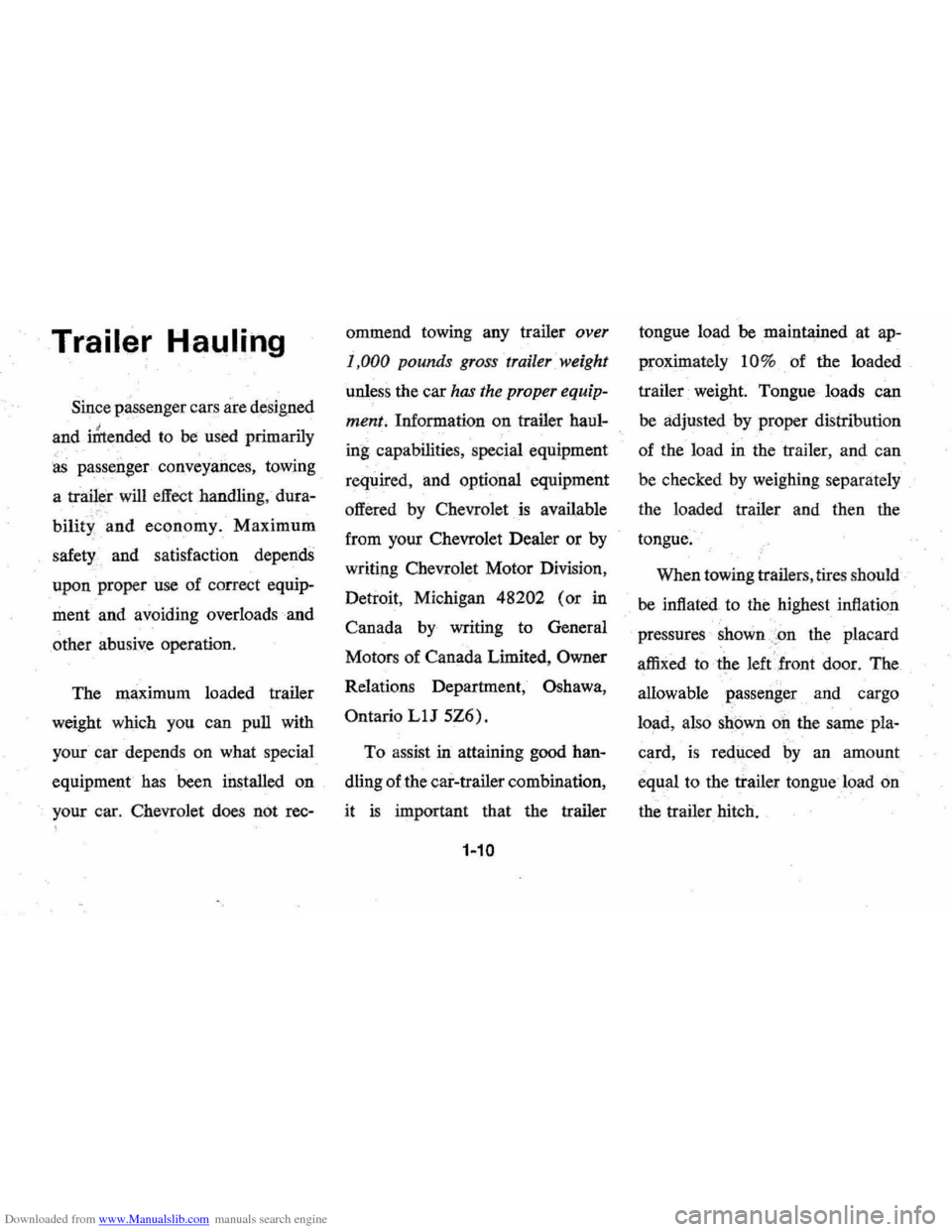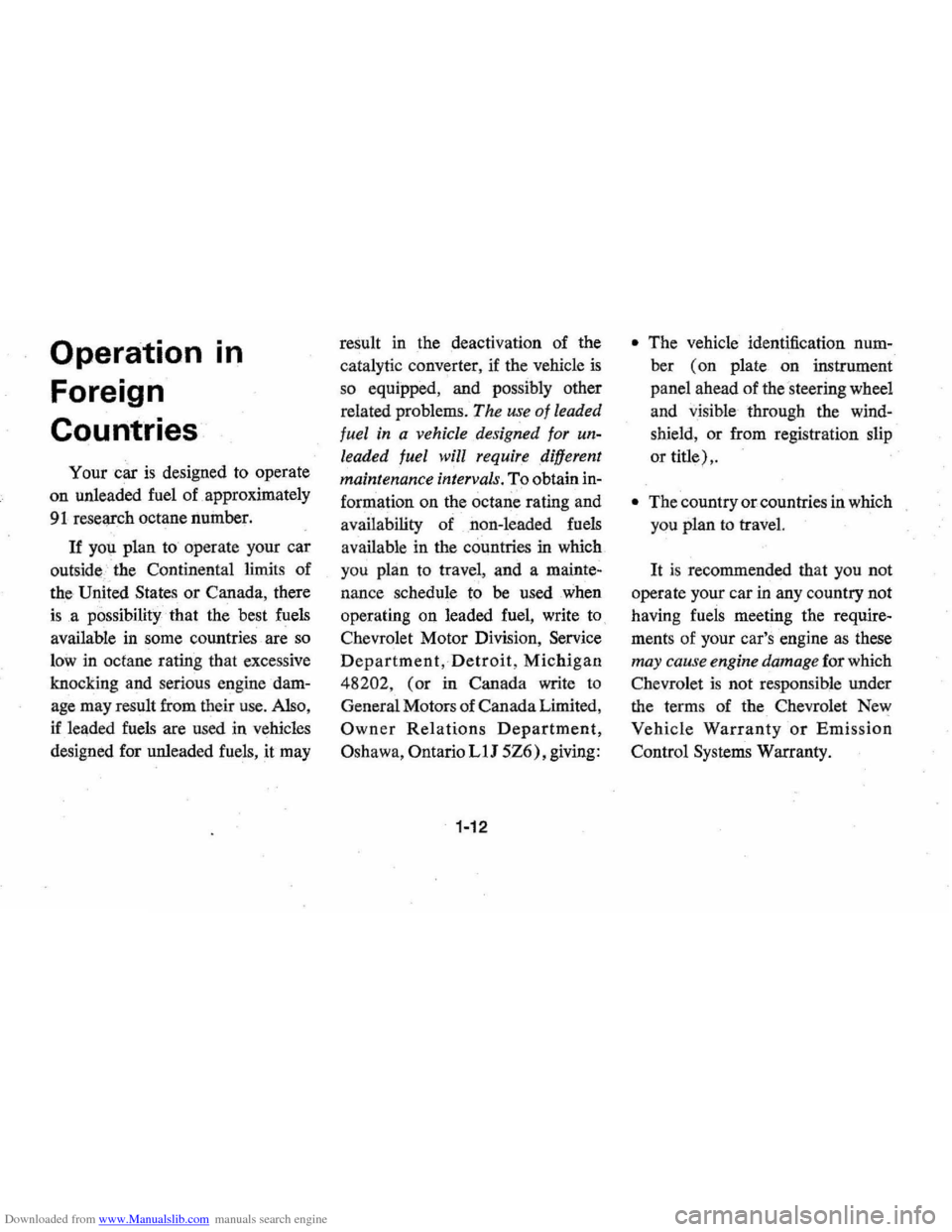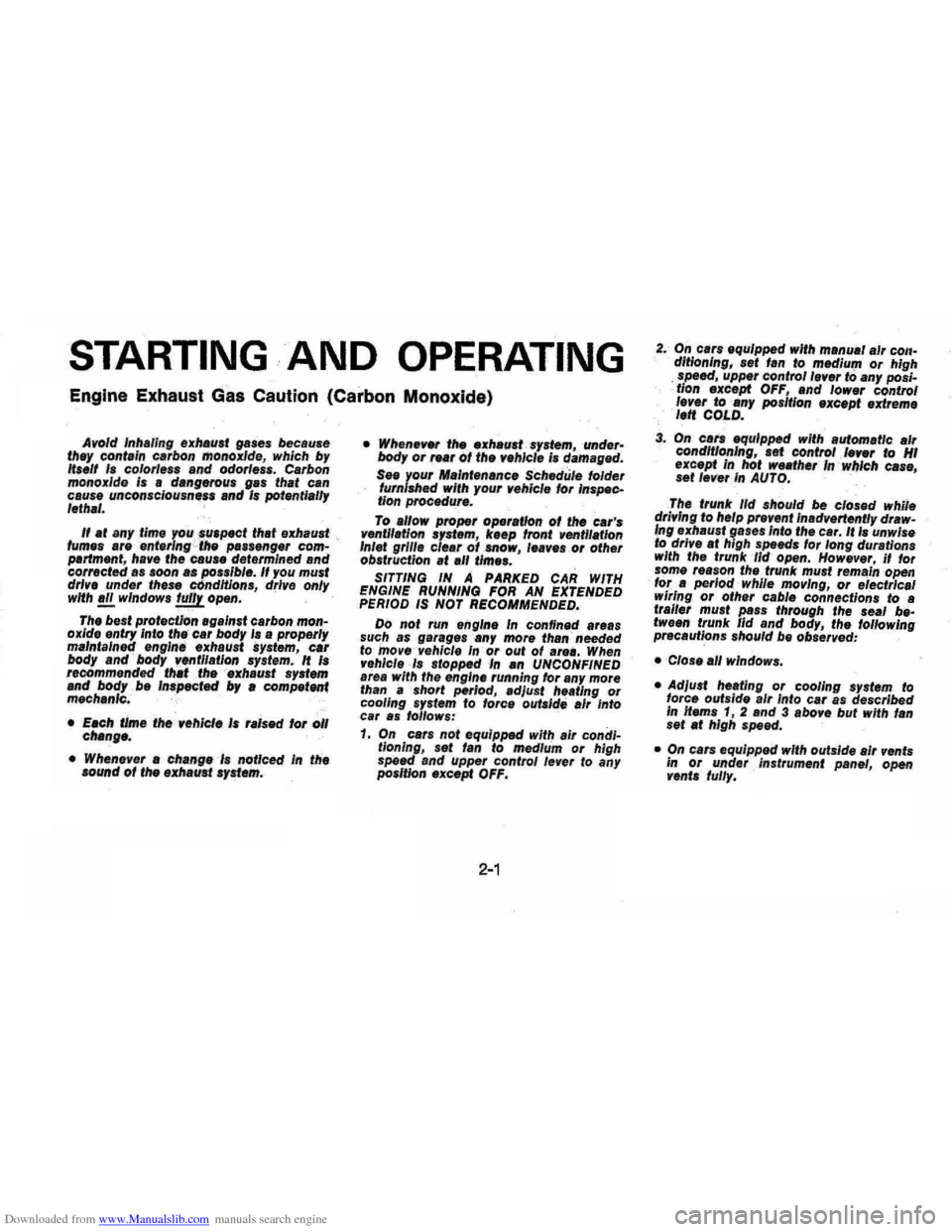Page 9 of 102

Downloaded from www.Manualslib.com manuals search engine o To fasten the· detachable shoul
der belt,
unstow it and place the
knob on the shoulder belt end
into the keyhole on the lap belt
latch plate.
(The latch is de
signed
so that this attachment
can only be completed before
fastening the lap belt.) Tilt the
knob as necessary , to pass it
through the slot.
Pull the knob
firmly upward to seat it at the
narrow end of the keyhole, then fasten
the lap belt. Reverse this
procedure when removing and
restowing the shoulder belt.
o The detachable shoulder belts
are lengthened and shortened in
the same manner as center seat
lap belts.
o The detachable shoulder belt
should have sufficient slack to
in
sert a fist's width between your
chest and the belt. This can be
checked
by inserting a clenched
fist between · the belt and your
chest with thumb against chest
and
back of hand facing upward.
Belt Restraint Inspection
o Periodically inspect belts,
buckles, adjustable latch plates,
1-7
retractors, reminder systems,
guide loops, clips,
and anchors
for damage that could lessen the
effectiveness
of the retraint
system.
o Keep sharp edges and damaging
objects away from belts, and
other parts of restraint system.
o Replace belts if cut, weakened,
frayed,
or subjected to collision
loads.
o Check that anchor mounting
bolts are tight.
o Have questionable parts re
placed.
o Keep belts clean and dry.
o Clean only with mild soap solu
tion and lukewarm water.
o Do not bleach or dye belts since
. this may severely weaken belts.
Head Restraints
o Head restraints are designed to
help reduce injuries due to
"whiplash".
Page 10 of 102

Downloaded from www.Manualslib.com manuals search engine • Select one of the two positions
-up or down-which places the
top of head restraint closest to
the top of your ears.
• Do not use head restraint above
the up detent position.
• Head restraint can be raised by
pulling up until you feel it click
into the
"detent" position.
• To .lower, release latch at base
of supporting rod and push down
on restraint.
• Do· not operate vehicle with
head restraints removed, since
occupants
lose the protection
they provide.
Child Restraint
Children in automobiles should
be restrained to lessen the risk of
injury in accidents or sudden stops.
. General Motors dealers offer re
straint systems designed specifically
for use with infants and with small
children. The GM
"Infant Love
Seat" is designed for babies up to
20 pounds. The GM "Child Love
Seat" (not available in Canada) is
designed for children weighing 20
to 40 pounds, up to 3 feet-4 inches
in height, who are able to sit up
alone.
In using any infant or child re
straint system, read and comply
with all installation and usage
in
structions.
H a child is traveling in a vehicle
1-8 not
equipped with a General
Motors infant or child restraint or
other appropriate. infant or child
restraint system, the following
pre
cautions should be taken:
1. Infants unable to sit up by them
selves should be restrained by
placing them
in a covered,
padded bassinet which
is placed
crossways in the vehicle
(width
wise) on the rear seat. The bassi-
Page 11 of 102

Downloaded from www.Manualslib.com manuals search engine net should be securely restrained
with the regular vehicle belt re
straints.
An alternate method is
to position the bassinet so that it
. rests against the back of the front
seat, again crossways in the
vehicle.
2. Children able
to ,sit up by them
selves should be. placed
on a seat
and restrained with a belt
re'
straint. When children ride in the
front seat, both lap and
shoulder belt should be worn.
If
the shoulder belt causes neck or
face irritati on due to the child's
size, this may be reduced in some
cases by positioning the child
further inboard.
If serious dis
c.omfort continues, the . child
sh.ould be lap belted in the rear
seat. Never allow a child to stand
.or kneel on any seat .
•
3. General ' M.otors recommends
that childr~n be restrained pr.op
erly when riding. However, if
unusual
c.onditi.ons pr.ohibit use
.of restraints and require' that a
child must stand, he
sh.ould stand
.on the floor directly behind the
front seat. This will help mini
mize the possibility
.of injury
from frontal
f.orce impacts in the
event .of an accident.
,
•
Page 12 of 102

Downloaded from www.Manualslib.com manuals search engine Trailer Halllihg
Since passenger cars are designed
and
i~ended to be used primarily
as passenger conveyances, towing
a
trailer will effect handling , dura-
" bility and economy. Maximum
safety and satisfaction depends
upon proper use of correct equip
ment and avoiding overloads and
other abusive operation.
The maximum loaded trailer
weight which you can pull with
your car depends on what special
equipment has been installed
on
your car. Chevrolet does not rec-ommend
towing any trailer
over
1,000 pounds gross trailer weight
unless the car has the proper (!quip
ment .
Information on trailer haul
ing capabilities, special equipment
required , and optional equipment
offered by Chevrolet
is available
from your Chevrolet Dealer or by
writing Chevrolet Motor Division,
Detroit, Michigan
48202 (or in
Canada by writing to General
Motors of Canada Limited,
Owner
Relations Department, Oshawa,
Ontario LlJ 5Z6).
To assist in attaining good han
dling of the car-trailer combination,
it is important that the trailer
1-10
tongue load be maintained at ap
proximately
10% of the loaded
trailer weight. Tongue loads can
be adjusted by proper distribution
of the load in the trailer, and can
be checked
by weighing separately
the loaded trailer and then the
tongue.
When towing trailers, tires should
be inflated to the highest inflation
pressures
shown :on the placard
affixed to
the left' front door. The
allowable passenger and cargo
load , also shown
on the same pla
card,
is reduced by an amount
eq ual to the trailer tongue load on
the trailer hitch.
Page 13 of 102
Downloaded from www.Manualslib.com manuals search engine . . "
Maintenance
More frequent vehicle mainte
nance
is required when using your
car
to pull a trailer. Change. the:
• Automatic transmission fluid
and filter each 15,000 miles,
(see Trai/ering brochure foraddi
tional information).
.• Rear axle fluid each 15,000
miles,
• Engine oil each 90 days or 3,000
miles , whichever occurs first,
• Positive crankcase ventilation
valve each
12 months or 15,000
miles, whichever occurs first.
• See index for important informa
tion on belts, cooling system care
and automatic brake
adjuslrilent.
Break·in Schec;!ule
In addition to the new car break-in
instructions in this manual, it
is
recommended that your new car
be operated for 500 miles before
trailer towing.
If it is necessary to
tow during this period, avoid speeds
over
50 MPH and full throttle
starts. The same precautions should
be observed whenever a new
en
gine , transmission or axle is in
stalled in your car.
1·11
Page 14 of 102

Downloaded from www.Manualslib.com manuals search engine Operation Foreign
Countries
.
In
Your car is designed to operate
on unleaded fuel
of approximately
91 reseljl'ch octane number.
If you plan to' operate your car
outs ide . the Continent al limits of
the
U niled States or Canada, there
is .a possibility that the best fuels
available
in some countries are so
low in oclane rating that excessive
knocking and serious engine dam
age may result from their
use. Also,
if leaded fuels are used in vehicles
designed for unleaded fuels, it may result
in the
deactivati on of the
catalytic converter, if the vehicle
is
so equipped , and possibly other
related problems.
The use of leaded
fuel
in a vehicle designed for un
leaded fuel
will require different
maintenance intervals.
To obtain in
formation on the
octan~ rating and
availability of non-leaded fuels
available in the countries in which
you plan to travel , and a mainte
nan ce schedule to
be used when
operating on leaded fuel, write to
Chevrolet Motor Division, Service
Department,Detroit, Michigan
48202, (or in Canada write to
General Motors of Canada Limited,
Owner Relations Department,
Oshawa, Ontario LlJ 5Z6), giving:
1-12
• The vehicle identification num
ber (on plate on instrument
panel ahead of the steering wheel
and vis ible through the wind
shield , or from registration slip
or title)
,.
• The country or countries in which
you plan
to travel.
It is recommended that you not
operate your car in any country not
having fuels meeting the require
ments of your car's engine
as these
may cause engine damage for which
Ch evr olet is not respon sible under
the term s of the Chevrolet New
Vehicle Warranty or Emission
Control Systems Warranty .
Page 15 of 102

Downloaded from www.Manualslib.com manuals search engine STARTING· AND OPERATING
Engine Exhaust Gas Caution (Carbon Monoxide)
Avoid Inhaling exhaust gases because
thay cont./n carbon mODOxlde, which by
1t'811 Is color/e.. and odor/elS. Carbon
monoxIde Is • dangerous gas fh,t can
caus. uneonsC /ousnftu and Is potentially
lelha/.
It at any time you .,u.pect that exhaust _
tumes ., •• nf.rlng'··the passenger com
partment , half' the -cause determined and
co".cfed a. soon as possible. II you must
drlv. under these c6ndltions, drive only
with a/l window. luliy open.
-
The best protection .gainst carbon mon
oxide entry Into the' C81 body Is a properly
maintained' engine exhaust system, car
body and body v.ntllallon syslem. /I Is
recommended tha' the -exhaust system
and body bo Inspecled by a compel"",
mechanic. .
• Each limo rhe vehlcl. I. ralsod lor 011
c"'ng8.
• Whn.If.r " change Is noticed in the
sound 01 IIH1 exhaul' sy~.m.
• Whene"., the ."haust system" 'under
body or TNr ot the .,ehlele is damaged.
S .. 1.0U1 Maintenance Schedule tolder
furn
shed with your .,ehle/. for Inspec
tion procedure .
To allow proper operation ot the car's
ventli.t/on system. keep tront ventilation
Inl.t grme e/hr at .now. I."ves or other
obstruction
.t .11 time,.
SITTING IN A PARKED CAR WITH
ENGINE RUNNING FOR
AN EXTENDED
PERIOD IS NOT RECOMMENDED.
Do not run ,.nglne In confined areas
such as ,garage. ",.iny more than needed
to mOlfe"vehic/. In' or' out of are •. When
v.hlc/ol • • 'opped In an UNCONFINED
ar •• with the engine running tor any more
than a 'short period , adJust he.ting or
cooling sy.tem to toree outside aIr into
car .s tollow,:
1. On cars not equipped with air condi
tioning.
set tan to medium or high
spefKi and upper control lever to any
poslUon oxcepl OFF.
2-1
2. ' On c." equipped with menu.' air call
dltlonlng, 8.t fIn to m.dium or high
speed. upper control lever to any pos;
: tlon except OFF, Ind lower contrOl
I.ver to Iny position except .xtrem •
. ,." COLD.
3. On cara equIpped with automatic a"
conditioning , .et control ,-.,e, to HI
except In hot wNther In .""lch cas.,
set lever In AUTO.
The Irunk lid should be closed while
driving to help prevent Inadvertently draw
Ing exhaust gases Into the car. It I. unwise
to drive .t high speed. for long dUrations
with
the trunk lid open. However, if for
some ,e.son the trunk must remain open
tor a period' whJle moving, or electrical
wiring
or other cabl. connections to a
trailer mu.t PlIS through the seal be
tween trunk lid and bo,dy, the following
precaut~ons shoUld be observed:
• Close all windows.
• Ad/u.t h •• tlng or cooling system to
force outside aIr Into car as described
In nem. 1, 2 and 3 abo,.e but with f.n
.al ., hIgh speod.
• On cats equipped with outside air vents
In or under Instrument panel, open
vonl. lully.
Page 16 of 102

Downloaded from www.Manualslib.com manuals search engine STEERING COLUMN CdNTROLS
Anti-. Steering
Column Lock
The
anti-th eft lock, located on
the right side of the stee ring col
umn, has five positions:
• Accessory -Permits operation
of electr i
cal accessories when
engine is not running. To
en
gage, push key in and turn
toward you (counterclockwise).
• Lock-Normal parking position.
L
ock s igniti on and provides added
theft protection
by prevent
ing normal operation of steering
wheel and shift controls . to
"lock"
po sition and removed until trans
mission is placed in "park".
• Off
-Permits turning engine off
without locking steering wheel and
shift controls.
• Run (ON) -Normal operating
position
. .
•
Start -Permits engagement of
starter.
NOTE: The ontl-theft otee,lng column lock is not 8:,lubltItUte tor· the parking brake. Always let the , parking brak, when leaving the car una"ended.
If difficulty is experienced in
turning the ignition key and lock
knob to unlock the ignition,
at
tempt to turn the steering wheel lIS
hard as possible in the direction the
wheels are turned.
At the same
time turn the ignition-lock knob in
2-2
a clockwise direction wi(h as.much
effort
as you can apply with your
own hand. Do not attempt to
use
a tool of any kind to apply addi
tional force on the lock knob, as
this could break the knob.
Parking
When leaving your car unattended:
• Set parking brake.
• Place automatic transmission se
lector in Park.
•
Turnkey to LOCK position.
• Remove key (the buzzer will re
mind you).
• Lock all doors.
IMPORTANT : Do not park your car over combustible materials, such 8S grlss or leaves, which can come Inlo contact with the hot exhaust system and cause such materials to Ignite under certain wind and weather condition ••
NOTICE:
Do not I.ave your car unattended with ~ engine running. If the engine
should overheat While your car is -unat·
tended , the temperature warning light or gauge would go unheed9d, which could result in extensive damage to your car.